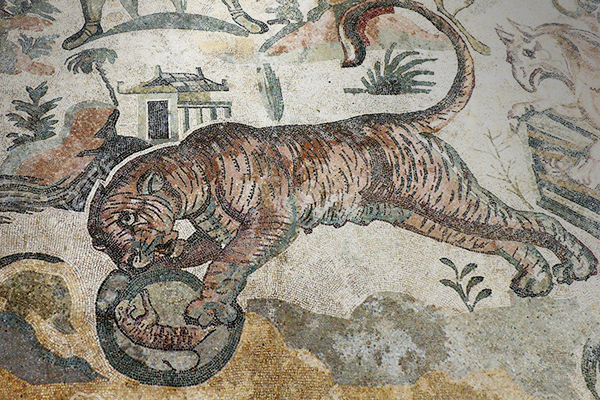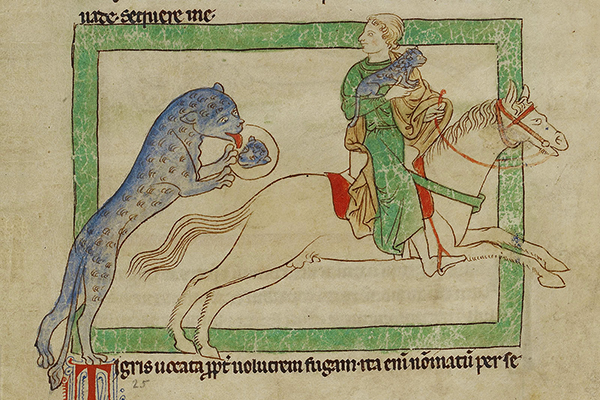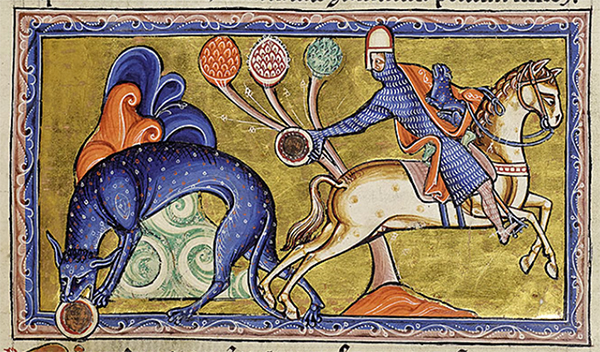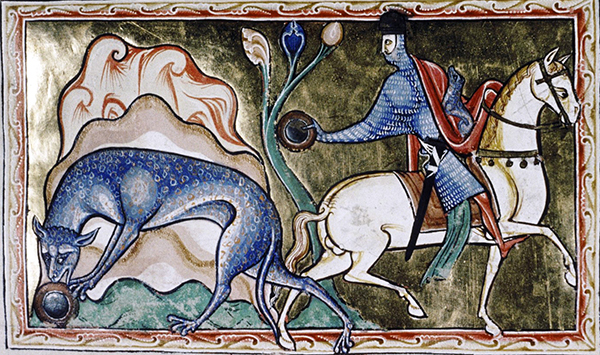"...the roaring of the Hyrcan tigress whose cubs the terrified horseman has carried off to be the playthings of Persia’s king. Speedier than the west wind that is her paramour rushes the tigress, anger blazing from her stripes, but just as she is about to engulf the terrified hunter in her capacious maw, she is checked by the mirrored image of her own form."
Claudian, Rape of Proserpine (III.263)
The earliest description of the tiger is not of a tiger at all—but of the mantichora (English manticore), a half-fabulous creature first mentioned in a lost history of India by Ctesias, a captured Greek physician who had served at the Persian court (Diodorus Siculus, Library of History, II.32.4) and once treated Artaxerxes II for a wound suffered in 401 BC at the Battle of Cunaxa (Xenophone, Anabasis, I.8.26). The mantichora was reputed to be as large as a lion and its skin as red as cinnabar. A native of India, where many were said to live, it was feared as a man-eater (its name in Persian), and killed and devoured men in great numbers—who, armed with spears or arrows and mounted on elephants, hunted and killed it in their turn (Indica, Frag. 45.15).
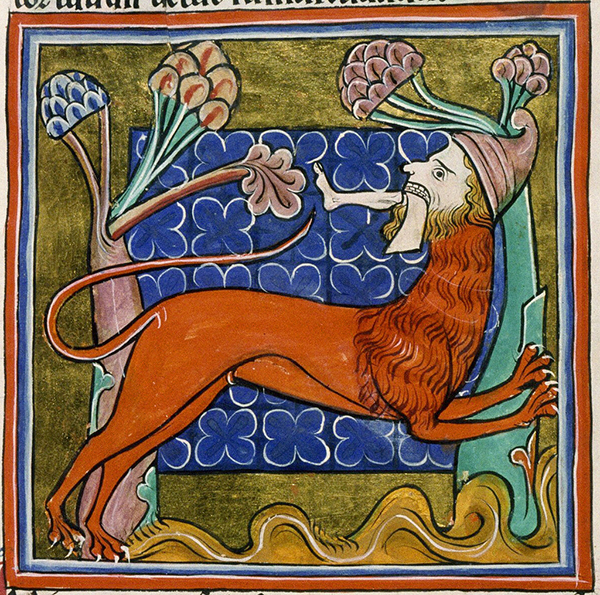
But Ctesias also relates the beast's more fantastic characteristics: the face, ears, and light-blue eyes of a human but with three rows of teeth, and deadly foot-long spines that shot like arrows from its scorpion-like tail, each growing back as soon as it had been released (which Harley MS 3244 attempts to depict as a single spine poised at the tip of the tail). It is this credulity that later so discredited Ctesias' pretensions as an historian. In the illumination from Bodley 764 (above), the mantichora has been portrayed with its lion's mane and red body, sharp claws and pointed tail—but also with a beard, hooked nose, and Phrygian cap to signify that the monster represented the Jew.
Aristotle adds that the mantichora was as swift as a deer and made a piercing sound like a flute or trumpet (History of Animals, II.1)—features that, on such authority, were repeated by Pliny (Natural History, VIII.xxx.75), Aelian (On the Characteristics of Animals, IV.21), and Solinus (Polyhistor, LII.37-38), who also says that its powerful leap could surmount even the widest spaces. But clearly Aristotle has misgivings, demurring "if we are to believe Ctesias" (II.1). Pausanias is dismissive as well, and presumes that Ctesias was describing a tiger, all the more imaginative details being nothing more than "a false story that the Indians pass on from one to another owing to their excessive dread of the beast" (Description of Greece, IX.21.4). As to a claim that he actually had seen such a creature (when one was presented to the Persian king as a gift) Aelian sniffs, as if Ctesias was "to be regarded as a sufficient authority on such matters" (IV.21). By the third-century AD, the mantichora could be discounted by someone such as Apollonius (a charismatic teacher and miracle worker who was compared to Jesus) as just one of many "tall stories" (as the Greek is translated) about the mythological animals of India in which he did not believe (Philostratus, Life of Apollonius of Tyana, III.45).
In an attempt to rationalize Ctesias' account, Nichols has suggested that the three rows of teeth might have derived from the three lobes of a tiger's molar. And, because the mantichora and tiger both are illustrated in the medieval bestiary, Yapp argues that the creature described by Ctesias was a cheetah. But such explanations really are not necessary. A naturalistic description of the tiger (its color and size, nature and origin) simply cannot convey how fearsome the animal must have seemed to the natives it devoured. For that terror to be understood, the attributes of the mantichora have to be manifest as well (as Pausanias had surmised). It's difficult, too, to think that the cheetah, which was known at the time, could have been confused with a tiger. Rather, the mantichora need only be what it was thought to be. As Augustine had said of faith, "it is a means by which those things that are not seen may be believed. We may believe whatever it signifies to us, not troubling as to how true such things might be" (Enarratio in Psalmum, "Expositions on the Psalms," LXVI.10).
A live tiger would not be seen by a European for another seventy-five years, when Alexander the Great, campaigning in India, was presented with tamed animals in 326 BC (Curtius, History of Alexander, IX.8.2)—although Nearchus, the admiral of Alexander's fleet, did claim to have seen a tiger skin (Arrian, Indica, XV, who goes on to say that the Indians imagined the tiger to be as big as the largest horse and stronger than an elephant, which it readily could kill). Alexander also was given mastiffs so fierce that they were thought to have mated with tigers (Diodorus Siculus, Library of History, XVII.92.1).
Two decades later, a pair of tigers were sent to Athens (Athenaeus, Deipnosophists, XIII.590a) by Seleucus I, one of Alexander's former commanders, in token of his subjugation of lands "as far as the river Indus," including Hyrcania (Appian, The Syrian Wars, IX.55), so named, says Isidore of Seville, after the Hyrcanian forest that was "full of savage wild beasts such as tigers, panthers, and pards" (Etymologies, XIV.3.33).
When, in 43 BC, Varro wrote on the origin and development of Latin, a tiger ("as it were, a striped lion") had not been taken alive, or so it was thought. Presumably, this was because of the tiger's speed, the etymology of tigris deriving from the Armenian (Persian) word for "arrow," after which the swiftly flowing river Tigris in Mesopotamia was named as well (On the Latin Language, V.20.100). In the first century AD, Strabo (Geography, XI.14.8) and Pliny (Natural History, VI.xxxi.127) both repeat this etymology. Originally feared for its savagery, the tiger now is characterized as "an animal of tremendous swiftness" (velocitatis tremendae, VIII.xxv.66). Such was the authority of early encyclopedists like Varro and Pliny that Isidore repeats the origin of the word in his own Etymologies (XII.2.7) more than half a millennium later.
Three centuries after a tiger had been seen in Athens, one finally was introduced to Rome. Tame and kept in a cage, it was publicly displayed to celebrate the dedication of the Theater of Marcellus in 11 BC, a gift to Augustus by an embassy from India about that time (Pliny, Natural History, VIII.xxv.65; Cassius Dio, Roman History, LIV.9.8). Likely, it was exhibited soon after it had arrived, as the emperor was said to be impatient when "anything rare and worth seeing was ever brought to the city" (Suetonius, Life of Augustus, XLIII.4). Strabo was in Rome in 7 BC, the year his Geography was published. The largest tigers, he says, were nearly twice as large as lions, and even a tame one being led by four men once seized a mule by the leg (XV.1.37). One would like to think that this was the same animal shown by Augustus four years before, as it would have been too rare and exotic to be sacrificed in the arena.
Even decades later, Claudius managed to exhibit only four tigers (Pliny, Natural History, VIII.xxv.66), and Nero may have displayed one in a gilded cage (Petronius, Satyricon, CXIX.17). By the end of the first century AD, if an obsequious Martial is to be believed, no huntsman on the Ganges ever fled on his Hyrcanian horse from so many tigers as then were to be seen in the Roman arena (Epigrams, VIII.26, likely in celebration of a triumph by Domitian in AD 93). In AD 148, Antoninus Pius held games in which tigers were presented (Historia Augusta, X.9). A century later, to celebrate the millennium of Rome's founding, Philip the Arab presented ten tigers in the arena, although it is not clear whether they were for display or slaughter (Historia Augusta: Gordian III, XXXIII.1). Commodus once did kill a tiger (as well as a hippopotamus and an elephant), the spectacle having been witnessed by the historian Cassius Dio who, as senator, had been obliged to attend (Roman History, LXXII.19.1). And Elagabalus was said to have harnessed tigers to his chariot after the fashion of Dionysus (Historia Augusta, XXVIII.2) and to have had fifty-one killed, "a larger number than had ever before been despatched at one time" (Cassius Dio, Roman History, LXXIX.9.2), although the number hardly is credible about an animal so solitary in the wild.
In about AD 43, during the reign of Claudius, Pomponius Mela described the Hyrcanian tiger in De Chorographia (alternately De Situ Orbis), the first geographical survey of the known world in Latin. There, he recounts that the tiger was so swift that a mounted rider could readily be tracked down—even at a distance and then more than once, each time the trail being retraced from its beginning. How is the hunter who has stolen its cubs possibly to escape such a ravenous beast, even on the fastest horse? The explanation, says Mela, is that the cubs are abandoned one by one, each of which is retrieved by the tigress and brought back to the den before she renews her pursuit. Only by this stratagem could the hunter hope to find safety among the populace of a nearby town (III.43).
Writing some thirty-five years later, Pliny (who repeatedly acknowledges Mela as one of his auctores or authorities) relates the same story: A native of Hyrcania and India, the tiger is an animal of exceptional speed, especially when deprived of her whelps. Pursued and surely to be overtaken on even the swiftest horse, which is frequently changed for a fresh one, the hunter is forced to give up the stolen cubs one at a time, each of which the tigress hurriedly returns to her den before again setting out in pursuit. By such means, the hunter escapes with at least one cub to a waiting ship, the mother venting her fury on shore (Natural History, VIII.xxv.66).
The third Roman to redact older Greek lore is Solinus who, writing in the third century AD, depended upon Pliny as his primary source. In Polyhistor (alternately De Mirabilibus Mundi), he speaks of the wild forests of the Hyrcanians teeming with tigers, their coats shining with a tawny color interspersed with black stripes that make for a most becoming contrast. But it is the "remarkable speed and well-known spots [that] have rendered this kind of beast famous." Solinus confesses not to know whether it is the speed or the endurance of the tiger that accounts for its swiftness, but "nothing can be so far ahead of them that they will not immediately overtake." It is her maternal instinct that compels the tigress to purse the thief, who conspires to have a series of fresh horses on hand in hope of getting safely to the sea. Such is the impotent rage of the mother at the loss of her cubs that she lunges at the shore if ever he is to be seen again, reproaching herself for her loss (XVII.4–7). By this metamorphosis, the savagery of the tiger has been made all the more fearful by its unbounded speed, which is more relentless still when stirred by the animal's instinct to recover her young.
By late the following century, the story again has been retold. Now, instead of the cubs themselves having to be given up one-by-one, a simulacrum is used instead to deceive the pursuing mother. The ingenuous ruse (and its Christian moral) was introduced by Ambrose in about AD 389. Bishop of Milan, he had disputed with the pagan senator Symmachus on religious tolerance just a few years before.
"Maternal affection makes gentle the savagery of the beast. Nature checks for the moment the ferocity of the tigress and turns her aside as she is on the point of seizing her prey. The minute she discovers that her young have been taken, she sets out on the track of the despoiler. Although he may have the advantage of a fast horse, he is aware that he maybe outdone in speed by the wild beast. In a situation where there is available no means of escape he has to resort to the following stratagem. When he perceives that he is being overtaken, he lets fall a glass ball [sphaera]. The lioness [sic] is deceived by her reflection, thinking that she sees there her young. After being retarded by the deceitful image, she once more expends all her strength in her effort to seize the horseman. Spurred on by rage, she comes closer and closer to her fleeing victim. Again he throws out the glass ball, thus slowing down his pursuer. Yet her remembrance of past deceits does not prevent her from complying with her maternal instincts. She keeps turning over the reflected image that deludes her and settles down on it as if to nurse her young. Thus, deceived by her own maternal solicitude, she suffers at once the forfeiture of her vengeance and the loss of her offspring" (Hexameron, "The Six Days of Creation," VI.4.21).
Mistaking her own reflection in the glass ball for that of her cub, the tigress pauses—and so allows the hunter to escape, this time with all the whelps. As to the edifying moral, Ambrose concludes that the nature of wild animals is simple but truthful and, like all ordained by God, those "to whom He has bestowed a minimum of reason are endowed with the maximum of feeling" (VI.4.22). Just as the wild animal instinctively loves its brood, so parents should not be estranged from their own children, a son despising his father, a father disinheriting his son—all oblivious to the dictates of nature.
In the early decades of the seventh century, Isidore of Seville, who died in AD 636, wrote the Etymologies (alternately Origins), an etymology being (as he defined it) "the origin of words, when the force of a verb or noun is inferred through interpretation....for when you have seen whence a word has originated, you understand its force more quickly. Indeed, one's insight into anything is clearer when its etymology is known" (I.29.1–5). It is this discernment, by which the true meaning of a word can be disclosed, that no doubt appealed to the compiler of the medieval bestiary. Some words, Isidore explains, derive from their innate quality. "The tiger is so called because of its rapid flight [velocitate mirabilis]," tigris being what the Persians and Medes called an arrow after which, too, the river Tigris was named because it was the most rapid of rivers (XII.2.7).
In about 1245, Bartholomaeus Anglicus, a Franciscan monk, wrote De Proprietatibus Rerum ("On the Properties of Things"), the most widely copied and translated encyclopedia of the Middle Ages. In his account of the tiger, a mirror supposedly has replaced the glass sphere—at least, as translated by John Trevisa in 1397 (there is no contemporary English version). But the Latin speculum is the same for both "mirror" and "glass," and it is not possible to tell from the bestiary illustrations whether the reflection is from one or the other. The intent is the same, however: to deceive the mother into thinking she has recovered her cubs, when in fact they have been spirited away, possibly as a pet in the royal household or later destined for the menagerie.
"when the hunter heareth the grutching [complaint] of that beast that runneth after him, hée throweth downe one of the whelpes, & the Tiger bitch taketh the whelpe in hir mouth, and beareth him into hir den, & layeth him therein, and runneth againe after the hunter: but in the meane time the hunter taketh a ship, and hath with him the other whelpes, and scapeth in that wise: and so she is beguiled, and hir fiercenesse standeth in no stéede....And he that will bears away the whelps, leaueth in the way great mirrours, the damme followeth and findeth the mirrours in the waye, and looketh on them, and séeth hir owne shaddowe and image therein, and thinketh that she séeth hir young therein, and is long occupied therefore to deliuer hir whelpes out of the glasse, and so the Hunter hath time and space for to scape: and so she is beguiled with hir owne shadow, and she followeth no farther after the Hunter to delyuer hir young" (XVIII.104).
At almost the same time, in 1244, Vincent de Beauvais does comment that glass mirrors backed with a coating of reflective lead were superior to those of polished metal (Speculum Naturale, "Mirror of Nature," II.78). And, by the mid-thirteenth century, small mirrors of convex glass were beginning to be introduced in Europe—but it was an invention far too rare and costly ever to be thrown away, even by someone pursued by a tiger. More than three hundred years later, glass windows still were so precious that, in 1556, when the Duke of Northumberland was away from his castle at Alnwick, it was deemed cheaper to remove their casements and put them in storage than to risk any broken glass.
(To be sure, Isidore had written that there was "no material more fit for mirrors [speculis aptior]" than glass, Etymologies, XVI.16.3. But the technology to produce a reflective mirror of clear glass simply did not exist then. Rather, he has misread Pliny, who had said of glass only that there was "no material of a more pliable [sequacior] nature than this," Natural History, XXXVI.lxvii.198—as both Beckmann and the translator of Pliny remark.)
Sometime before 1218, Pierre de Beauvais (Bestiaire, II.140) attributed the tiger's delay in pursuing the hunter, not to solicitude for an abandoned cub, but to the pleasure she took in adoring her own reflection. In Le Bestiaire d'Amour, the learned cleric and troubadour Richard de Fournival goes further, appropriating the allegorical stories of the bestiary in a cynical plea for the affection of an unobtainable lady. Writing in the mid-thirteenth century, he juxtaposes the Christian metaphors of the bestiary and the romantic motifs of courtly love to woo his beloved. The five senses provide a thematic continuity and the bestiary animals themselves either exempla for her to emulate or avoid. The lover's sight of the lady, for example, bewitches him as surely as did the mirror for the tiger. "For however great its rage if its cubs have been stolen, if it comes upon a mirror it has to fasten its eyes upon it. And it so delights in gazing at the great beauty of its good form that it forgets to pursue the men who stole its cubs. It stands there as if captured. Wherefore clever hunters put the mirror there on purpose to rid themselves of the tiger."
Later, in a Response that was appended to several manuscripts of Le Bestiaire d'Amour, the lady herself replies to such blandishments, retorting that "just as mirrors [mireoirs] are strewn in front of the tiger to transfix it, so you produce for me your beautiful words. They are more delectable to hear than the tiger is to see...and I know well that you would not care who perished by them as long as your will be done." She continues the analogy by then referring to the unicorn, for no beast is to be feared like a deceptively soft word—against which there is as little protection as from the unicorn, for nothing is so wounding or likely to pierce a hard heart as fair speech.
Unlike the reflective glass ball, however, a mirror is freighted with Christian symbolism and allegory. One need only read Isidore's definition: "Mirrors (speculum) are what women use to look at their faces" (Etymologies, XIX.31.18). Maternal devotion has been replaced by human pride and female vanity. If the tiger once was deceived by her own reflection, she now is bewitched and held captive by it. So, too, is the sinner seduced by imagined earthly temptation and worldly delight. The tiger may have lost her cub, but in the vain attempt of mankind to recover a lost soul, salvation itself has been forfeit.
Once a marvelous figment only half-imagined, by the thirteenth century the tiger has become an exemplum for human behavior, less significant for its own sake than for what it could teach mankind. As the English cleric Thomas of Chobham wrote in 1220 in Summa de Arte Praedicandi, a treatise on the art of preaching—
"The Lord created different creatures with different natures not only for the sustenance of men, but also for their instruction, so that through the same creature we may contemplate not only what may be useful to use in the body, but also what may be useful in the soul....there is no creature in which we may not contemplate some property belonging to it which may lead us to imitate God, or some property which may move us to flee from the Devil. For the whole world is full of diverse creatures, like a manuscript full of different letters and sentences in which we can read whatever we ought to imitate or flee from" (VII.1-2).
And, like the manuscript, the English bestiaries of the twelfth and thirteenth centuries taught those who gazed upon its gilded images how their lives should be led.
Probably written at Lincoln about 1185 (the inscription is dated 1187), the Worksop Bestiary (MS M.81) is the earliest example of the so-called Transitional Family of bestiaries, which adheres to the order of beasts from Physiologus, an Alexandrian text written in Greek about the second century AD (or possibly as late as the fourth), but adds material from the Etymologies of Isidore, and presents mammals, birds, fishes, and reptiles as separate groups. It once was owned by William Morris, who purchased it in 1896 for £900, a considerable sum both for the man and his time. Already in ill health, Morris died five months later, almost to the day, the extravagant purchase no doubt gratifying a last indulgent wish. The manuscript now is in the Morgan Library and Museum (New York).
A copy of the Worksop Bestiary (although not direct, as the beaver, for example, is illustrated differently in the two manuscripts), Royal 12 C.xix was presented to the British Museum by King George II in 1757. From central or northern England (possibly Durham) and dating to about 1200, it, too, is a Transitional bestiary, the family in which the tiger first appears (although James considered both manuscripts to be First Family because they begin lion...antelope). But, unlike the Worksop Bestiary, which portrayed the cinnabar-red tiger as described by Ctesias, here it is rendered in blue, vividly illuminated within a heavy banded frame against a gold ground. A comparison with other bestiaries in the same family reveals that the manuscript is missing several quires, with the resultant loss of a dozen or so beasts (real and imagined), as well as an equal number of birds, and all the fishes.
The Northumberland Bestiary (MS 100), as it now is called, also may be from northern England and dates to about 1250–1260. It is almost identical to Royal 12 C.xix and even may have been copied from it, but, unlike the richer colors and gold grounds of more luxurious Transitional bestiaries, the drawings are outlined in brown ink and delicately tinted by layers of colored wash, the pigmented tones allowing for subtle gradations of color. Some of the images, too, are drawn more naturalistically, even if the colors are purely decorative and conventional. Originally owned by the Duke of Northumberland, the Alnwick Bestiary (named after the ancestral seat at Alnwick Castle), it was sold at auction in 1990 to a private collector in the United States for £2,970,000 ($5,834,565, the rate of exchange on the date of sale)—the highest price ever paid for an English manuscript. One of the last bestiaries still in private hands, it was purchased (after a failed earlier attempt) in 2007 by the J. Paul Getty Museum (Los Angeles) for a reputed (and quite breath-taking) £20,000,000.
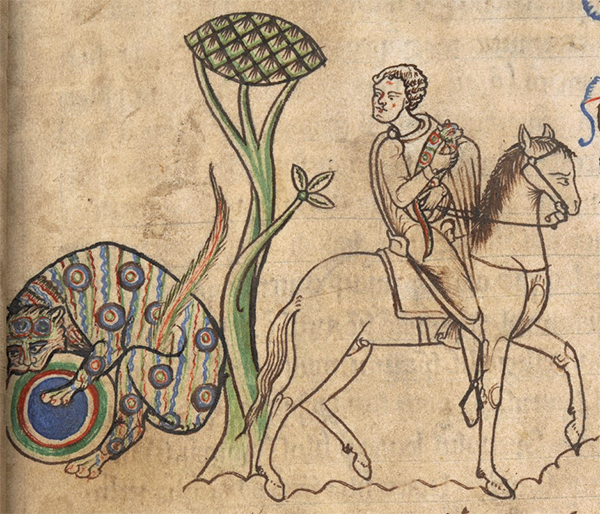
Dating to about 1170–1180, Additional MS 11283 (British Library) is the earliest example of a Second Family bestiary, the largest group and all of English origin—as James, who was the first to categorize the Latin bestiaries in England into families, contends. It follows the order of the beasts as presented in Book XII (De Animalibus) of Isidore's Etymologies, beginning lion...tiger, and is supplemented by additional material, principally from Solinus and Ambrose but also from the Pantheologus by Peter of Cornwall (1189) and the encyclopedic De rerum naturis by Rabanus Maurus (AD 846), itself a rearrangement of Isidore.
The illustrations of Add. MS 11283 are mainly in brown ink, with some in a color wash, like the parti-colored tiger above (which Klingender characterizes as "a particularly fine drawing"). Solinus had said that "Their remarkable speed and well-known spots have rendered this kind of beast famous" (Polyhistor, XVII.5). On the authority of such auctores, tigers, which had not been seen in Europe since the third century AD, were depicted with spots—which is curious, given that it is the Panther that has "small spots daubed all over it, so that it can be distinguished by the circled dots upon the tawny and also by its black and white variegation" (as the Cambridge Bestiary phrases it). Notice in the Second Family grouping that the tiger now has turned away from the hunter to tend her cub.
The Aberdeen Bestiary (University of Aberdeen, MS 24), c. 1200–1210 is characterized (like the Ashmole Bestiary below) by large illuminations on burnished gold grounds, arbitrary but imaginative coloring, symmetrical patterns, and an emphasis on artistic impression rather than natural observation—the very attributes that make these luxurious bestiaries so engaging. Indeed, for Clarke, the choice and use of color "put the Aberdeen and Ashmole bestiaries among the major colorists of the history of painting." The tiger, for example, is painted in ultramarine, the rare pigment having been prepared from lapis lazuli imported from a single region in Afghanistan. Finely ground, boiled with resin and then soaked in lye, the extracted color was the most intense pigment known and more precious than gold.
For James, the illustrations seem to be the bestiaries' only attribute. "But for its pictures I do not think that the Book [the Cambridge Bestiary] could possibly have gained or kept any sort of popularity." Only its "many beautiful and many curious images" seem to have justified "the spending of some labour on the tracing of its history." In a lecture several years later, James was no less emphatic, declaring that the bestiary has "no scientific or literary merits whatever" and would not even have attracted much attention were it not for the fact that it had been furnished with pictures. And, in fact, it was as a picture book that he examined them, limiting himself only to those English manuscripts in Latin that were illustrated.
But James is mistaken, as the editor's introduction to Bodley 764 makes clear. One of the longest chapters in that bestiary is on horses and offers a trove of information on the care, value, breed, color, strength, speed, and suitability that "no social historian of the Middle Ages can neglect."
Closely related to the Aberdeen Bestiary (James calls them "sister manuscripts"), the Ashmole Bestiary (MS Ashmole 1511), c. 1210, is perhaps the most luxurious and expensively produced bestiary, although it has been mutilated by the loss of several large illuminations cut from the page. The bestiaries, too, are similar in their inclusion of the Aviarium by Hugh of Fouilloy (written sometime in the two decades after 1132). In both of these manuscripts, the hunter has another glass ball ready to be thrown down as soon as the tiger realizes she has been deceived. In the Ashmole Bestiary, which is in the Bodleian Library (Oxford), the mirror is silver and blank, whereas in the Aberdeen Bestiary it is golden and reflective.
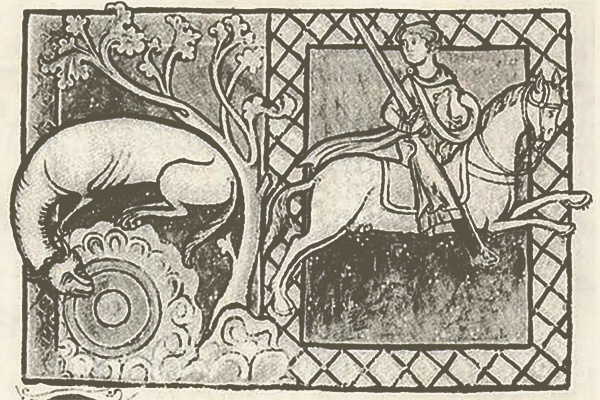
The Cambridge Bestiary (MS Ii.4.26) is in the University Library and dates to about 1200 (or even as late as the 1220s) and possibly is from Lincolnshire. Although the lion is illuminated in color, the majority of the illustrations are simple ink-and-wash drawings (but they may have been intended to be colored). In 1928, James reproduced this manuscript for a private printing by the Roxburghe Club, a society devoted to the publication of rare texts. There, he offers "a Preliminary Study of the Latin Bestiary as Current in England," in which he first proposed that they be classified as belonging to one of four families, each with shared characteristics—a categorization later revised by McCulloch who, rather than combining the features of First and Second Families, adds a Transitional Family). In 1954, James' facsimile was used by T. H. White (the author of the The Once and Future King) to provide the first and for some time, the only, translation of a bestiary in English. Barber's translation of Bodley 764, for example, did not appear until 1992. The tigress, "taken in by her own reflection, assumes that the image of herself in the glass is her little one [and] curls herself round the vain reflection....And so, deceived by the zeal of her own dutifulness, she loses both her revenge and her baby."
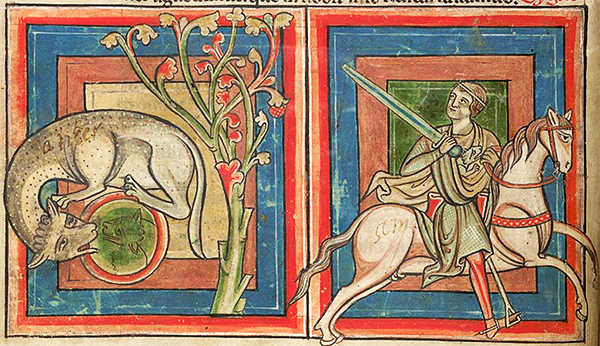
Harley 4751 is associated with Salisbury and dates to about 1225–1250. Although no gold leaf is used, it still is considered a luxury manuscript by virtue of its broad color panels and large illustrations, many of which derive from the Cambridge Bestiary. With birds from the Aviarium by Hugh of Fouilloy and the Topographia Hibernica ("Topography of Ireland," c. 1188) by Gerald of Wales, both it and Bodley 764 are among the most comprehensive Second Family bestiaries. Additions include three birds to be found in Ireland: the barnacle goose (I.11), osprey (I.12), and dipper (I.13), which Gerald called "martinets" and were thought to be a local variety of kingfisher. There also is the badger (I.20) which, in digging a burrow, allowed the dirt to be piled up on its belly like a sledge. Then, by means of a stick held in its teeth, the creature and its mound of excavated soil were pulled backward out of the newly-dug hole by its compatriots.
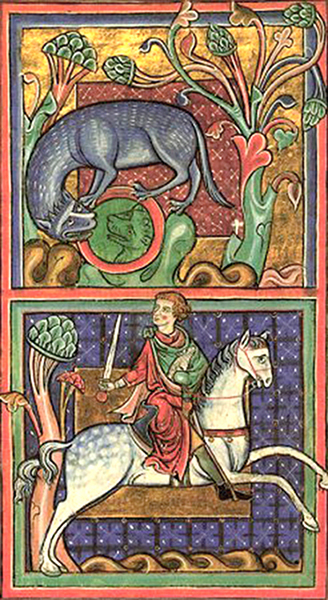
Bodley 764 (Bodleian Library) is another example of a luxury manuscript, with rich colors and masterful illuminations. Closely related to Harley 4751 and produced about a decade later, this bestiary may be the only one that can be ascribed to secular patronage, as the heraldic shield so prominently displayed in the elephant and castle illumination likely belonged to Roger de Monhaut, a baron of the Welsh Marches, who commissioned the book—and presumably enjoyed the hunt, which here is rendered with special drama and even violence.
Women, too, are depicted in scenes that otherwise lack them (a noblewoman is shown hawking, for example) and, when animal species are presented, the female is shown more often than in other manuscripts. Bodley 764 would seem, therefore, intended to appeal to well-born ladies as well. And the tiger is unusual in that it is presented in its own panel, apart from the hunter. The moral, as the tigress stops to retrieve what she thinks to be her abandoned offspring, is that (as Barber translates) "the intensity of her motherly love betrays her, and deprives her of both her revenge and her cub."
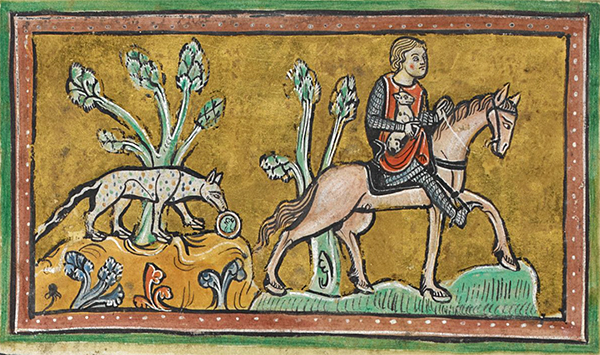
The Rochester Bestiary (Royal MS 12 F XIII), named after the Benedictine Cathedral Priory there, dates to about 1230 and includes additions from the Pantheologus of Peter of Cornwall. It is characterized by McCulloch as a Second Family bestiary but "unrelated iconographically" in that it does not resemble the pictorial motifs of other manuscripts in the family. Here, for example, the rider has turned completely away from the tiger, which also is pictured differently, neither rampant (as in the Transitional bestiaries) nor curled about the sphere (as in the Second Family), but stiffly staring at her reflection.
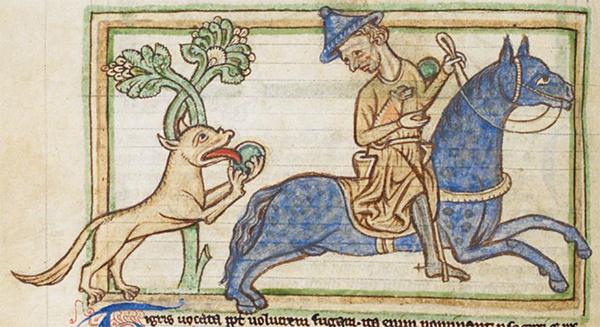
Humans are not often depicted in the medieval bestiary which, after all, is a book of beasts. But, when they are, the portrayal usually is not favorable. In stealing the tiger's cubs, the noblemen mounted on their stallions invariably are richly attired in flowing mantles or draped in costly chain mail, imagery that suggests the sin of pride (as the beguiling mirror does for the tiger herself). Their heads, too, often extend beyond the border of the frame, as if swollen with pride. And they invariably kill or otherwise maim the very creatures from which they were supposed to learn: the trapped antelope, its saw-like horns entangled in branches; the unicorn embraced in the lap of a maiden; the bonnacon emitting a defiant fart as it tries to flee; the beaver, "none more gentle," castrating itself to avoid being killed for its prized testicles—all are shown being pierced by a lance.
The image above is from Harley MS 3244 (British Museum), a Second Family Bestiary dating to about 1255 (if the elephant in the manuscript has been drawn from the one presented that year to Henry III). Lightly tinted in washes of browns, blues, and greens, the illustrations are not as sophisticated as many others. What is curious is that the rider neither is bare headed nor wears the helmet of a knight. Rather, he prominently displays the pileum cornutum ("horned cap"), the cone-shaped hat worn by Jews in medieval Europe that publicly differentiated them from the rest of the population, as promulgated by Pope Innocent III at the Fourth Lateran Council in 1215 and adopted in England three years later. The iconography is reinforced by the hunter's prominent nose, a physiognomy that often characterized the Jew, as did a beard—compare, for example, the mantichora in Bodley 764 (top) and the elephant handler in the Cambridge Bestiary. Given the opprobrium already associated with the hunter, the caricature no doubt reinforced that unfavorable image.
In 1190, there were anti-Jewish riots in York that were repeated throughout England during the thirteenth century until, a hundred years later, Jews were expelled from the country. Indeed, so virulent was the animus toward Jews in the Middle Ages that they were compared to the hyena, which in the bestiary is depicted disinterring a corpse from the tomb and devouring it. To make the association even more explicit, the hyena in the Aberdeen and Ashmole bestiaries is shown to be circumcised. In those remarkable images, it is obvious, too, that the beast is hermaphroditic, displaying the genitals of both male and female—a duality thought to signify the duplicitous Jew who once worshipped God but then idols (and a confusion about gender that Aristotle had discredited sixteen-hundred years earlier in History of Animals, VI.32). One begins to wonder, as well, if the rigid serrated spine of the hyena, which supposedly did not allow it to turn without moving the entire body, recalled a stiff-necked race too stubborn to recognize Christ as the Messiah.
Unique to Harley 4751, the body being exhumed is that of a naked woman, which suggests to Strickland that the image is a symbolic reference to the 1215 promulgation that Jews be distinguished by their clothing and so lessen the possibility of any inadvertent sexual relations with Gentiles. To that end, "Jews and Saracens of both sexes in every Christian province and at all times shall be marked off in the eyes of the public from other peoples through the character of their dress" (Canon 68).
Oppian, writing Cynegetica sometime after AD 212 when Caracalla, to whom the poem is dedicated, assumed the throne, tells the fanciful story of the tiger being sired by the West Wind.
"Next let us sing the Tiger of glorious form, than which cunning nature has vouchsafed naught more pleasant for the eyes to behold amid the great company of wild beasts. As much doth the Tiger excel among wild beasts as the Peacock doth for beauty among the fowls of air. Every way like a lioness of the hills wouldst thou behold it, apart only from the hide, which is variegated, with darkling stripes and brilliant sheen. Like are the eyes that lighten with fiery flash beneath the brows; like the body, strong and fleshy; like the long and bushy tail; like the face about the mouth; like the frowning brows above; like the gleaming teeth. Swifter is it than all wild beasts that are; for it runs with speed like its sire, the West Wind himself. Yet the West Wind is not its sire; who would believe that wild beasts mated with an airy bridegroom? For that also is an empty tale, that all this tribe is female and mates not with a male; for often mightst thou see its handsome spouse of many colours, but not easily couldst thou capture him; for he leaves his young and flees amain when he descries the hunters; but the female follows her cubs and in the anguish of her heart—to the great joy of the hunters—comes straight to the nets" (III.340–363).
Mares, too, were thought to be conceived by Zephyrus (Virgil, Georgics, III.271–277). Columella (Res Rustica, VI.27), Pliny (Natural History, VIII.lxvii.166), and Solinus (Polyhistor, XXIII.7) all remark on the horses of Spain being impregnated by the wind—as was Flora, the goddess of spring and Zephyrus' bride (Ovid, Fasti, V.195ff).
The fecundating power of the invisible wind was used by the early church to argue for the reasonableness of the Virgin Birth. About the same time that Solinus was writing, the Christian apologist Lactantius argued that "if it is known to all that certain animals are accustomed to conceive by the wind and the breeze, why should any one think it wonderful when we say that a virgin was made fruitful by the Spirit of God, to whom whatever He may wish is easy" (Divine Institutes, IV.12)? Even by the early the fifth century AD, Augustine still could proclaim in a chapter entitled "That There are Many Things Which Reason Cannot Account For, and Which are Nevertheless True" that mares were impregnated by the wind (City of God, XXI.5).
When the Getty Museum acquired the Northumbrian Bestiary in 2007, the manuscript was digitized and the high-resolution images freely made available to the public. That same year, a French translation of a bestiary ascribed to Pierre de Beauvais was auctioned by Sotheby's. It had been purchased almost forty years earlier by an anonymous buyer who had held it all that time, thus denying scholars such as Mermeir, whose was working on the longer version of the text, any chance to study it. Such is the difference between public access and private pleasure.
In the ninth century AD, Ctesias was epitomized by Photius in the Bibliotheca, a summary of all the books that he had read. It is the most complete account of both Indica and Persica, a lost history of Persia, although fragments do survive in the citations of other authors. Having consulted Persia's royal archives, Ctesias boasted that "he carefully investigated the facts about each king, and when he had composed his history he published it to the Greeks" (Diodorus Siculus, Library of History, II.32.4). And it is this history that Diodorus used in his own account of Mesopotamia, India, Scythia, and Arabia (II.2.2). Plutarch, too, quotes extensively from Ctesias in his Life of Artaxerxes, although doubtless annoyed that he had to depend upon someone whose work included such "a perfect farrago of extravagant and incredible tales" (I.2). Ctesias is chided, as well, by Lucian, who criticizes him for writing about India when he had never been there and places him in the Isle of the Wicked, where the harshest punishment is meted out to those who have falsified and not written the truth (True History, I.3, II.31).
The Athenian orator Demetrius, on the other hand, averred that "Altogether this poet (for a poet Ctesias may well be called) is an artist in vividness throughout his writings" (On Style, 215). And it is not the function of a poet, as Aristotle had stated, "to relate what has happened, but what may happen—what is possible according to the law of probability or necessity." The difference between the historian and the poet, in other words, "is that one relates what has happened, the other what may happen" (Poetics, IX.1-3). In this sense, Ctesias may be considered more a writer of historical romance than history itself—a style perfectly in keeping when the subject was India: a land on the fringes of the known world, exotic and unfamiliar, and inhabited by equally strange and fabulous creatures. Never having visited India, which is to say the parts that then were known (the northwest region of the country and the broad watershed of the Indus River), Ctesias had to rely upon the inchoate accounts of those who had—just as the modern reader has to depend upon the excerpts of later authors, who themselves often were more interested in these same marvels.
A final note: In the mid-fourth century BC, Aristotle posited that "opisthuretic animals copulate with a rearward presentment, as is the case with the lion, the hare, and the lynx" (History of Animals, V.2). An animal, in other words, that urinated backwards (one that was retromingent, to use an equally archaic term) was thought necessarily to copulate back to back as well. On this authority, the Cambridge Bestiary averred that lions "copulate the backward way," as did lynxes, camels, elephants, rhinoceroses, tigers, and hyenas. Writing in 1646, Sir Thomas Browne sought to correct such misapprehensions. Looking at the royal coat of arms, for instance, it was evident to him that "if in the Lion the position of the pizell be proper, and that the natural situation; it will be hard to make out their retrocopulation," as he was the first to phrase it (Pseudodoxia Epidemica, or Vulgar Errors, V.19).
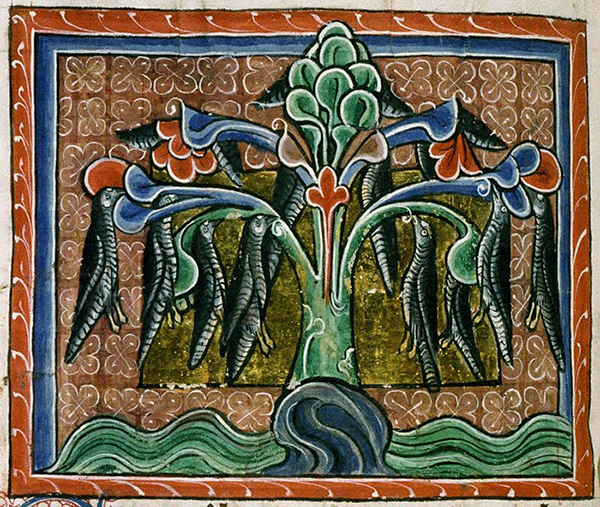
This illumination is from Bodley 764 and shows the barnacle goose described by Gerald of Wales suspended motionless by its bill (a similar picture illustrates Harley 4751, the only other bestiary in which the bird is included). Migratory, its Arctic nesting grounds never having been seen, the goose was not believed to lay eggs. Rather, it was thought to have developed inside a barnacle shell, generated there by the logs to which it was attached. Gerald remarks that he had seen thousands of these shells on timbers along the shore, imagining them to contain embryonic geese. Thus protected, the birds hung there until they acquired feathers and could drop into the water or fly away.
Because the barnacle goose was not born of the flesh, it was not considered to be flesh (cf. John 3:6, "That which is born of the flesh is flesh") and so was eaten without scruple by the Irish clergy on fasting days, much to Gerald's opprobrium. Conceived in this "very unaccountable and curious manner," the goose also was thought to be without sin and so analogous to the Virgin Birth, which provided the bestiarist an opportunity to chastise the recalcitrant Jew for refusing to accept such doctrine. "You hate, to your downfall, because you are obstinate in your malice" (Bodley 764). This motif of Jewish obstinacy is recurrent in the medieval bestiary and derives from Christian eschatology. The Second Coming of Christ was not to occur until the conversion of the Jews. As Jesus himself had declared, "Ye [Jerusalem] shall not see me henceforth, till ye shall say, Blessed is he that cometh in the name of the Lord" (Matthew 23:29). But with a venerable faith already, they were not inclined to adopt another one, their stubborn refusal thereby delaying the Second Coming and the ultimate resurrection of Christians.
The tiger and her reflected cub (top) are from the "Great Hunt" mosaic at Villa Romana del Casale (Piazza Armerina, Sicily) and date to the first quarter of the fourth century AD, more than half a century before Ambrose wrote about his own simulacrum. Claudian composed his poem later that same century. Its allusion to the tigress' paramour being the West Wind alludes to the belief that an animal as swift as the tiger surely must have been impregnated by Zephyrus himself. Even though the gentlest of the four winds, he was the harbinger of spring, when animals most were wont to mate.
The bestiary illustrations come from their respective museums' website, with the exception of the translation by White, which has been taken from the book itself. There are half again as many illustrations of the tiger and her cub, including those in the French bestiaries, but the Traditional and Second Family bestiaries shown here, which date from about 1185 to 1250, are the most elaborate and aesthetically satisfying—with Aberdeen and Ashmole holding pride of place.
References: Mediaeval Lore from Bartholomew Anglicus (1905) by Robert Steele; Pomponiuis Mela: Description of the World (1998) translated by F. E. Romer; Gaius Iulius Solinus, the Polyhistor (2011) translated by Arwen Apps (PhD dissertation); Ambrose: Hexameron, Paradise, and Cain and Abel (1961) translated by John J. Savage (The Fathers of the Church: A New Translation, Vol. 42); Bestiary: Being an English Version of the Bodleian Library, Oxford M.S. Bodley 764 (1992) translated by Richard Barber; The Etymologies of Isidore of Seville (2006) by Stephen A. Barney, W. J. Lewis, J. A. Beach, and Oliver Berghof; Batman vppon Bartholome his booke De proprietatibus rerum, newly corrected, enlarged and amended... (1582) edited by Stephen Batman; Beasts of Love: Richard de Fournival's Bestiaire d'amour and the Response (2003) translated by Jeanette Beer; The Complete Fragments of Ctesias of Cnidus (2008) translated by Andrew Nichols (PhD dissertation; published as Ctesias: On India); Animals in Roman Life and Art (1973) by J. M. C. Toynbee; Claudian (1922) translated by Maurice Platnauer (Loeb Classical Library); The Culture of Animals in Antiquity: A Sourcebook with Commentaries (2018) by Sian Lewis and Lloyd Llewellyn-Jones; "Animals Impregnated by the Wind" (1936) by Conway Zirkle, Isis, 25(1), 95–130; Oppian, Colluthus, Tryphiodorus (1928) translated by A. W. Mair (Loeb Classical Library); Animals for Show and Pleasure in Ancient Rome (1937) by George Jennison; A Medieval Book of Beasts (2006) by Willene B. Clark; The Bestiary; Being a Reproduction in Full of the Manuscript II.4.26 in the University Library, Cambridge, with Supplementary Plates from Other Manuscripts of English Origin, and a Preliminary Study of the Latin Bestiary as Current in England (1928) edited by M. R. James; Medieval Latin and French Bestiaries (1962) by Florence McCulloch; A Medieval Book of Beasts: Pierre de Beauvais' Bestiary (1992) translated by Guy R. Mermier; The Naming of the Beasts: Natural History in the Medieval Bestiary (1991) by Wilma George and Brunsdon Yapp; A History of Inventions, Discoveries, and Origins, Vol. II (1846) by John Beckmann (the reference to Vincent de Beauvais has not been confirmed in the original Latin); "The Bestiary" (1931) by Montague Rhodes James, History: The Quarterly Journal of the Historical Association, 16(61), 1-11; Medieval Beasts (1990) by Ann Payne; "The Northumberland Bestiary and Its Group" (1991) by Ann Payne, in Sotheby's Art at Auction 1990-91, edited by Sally Prideaux; Book of Beasts: A Facsimile of MS Bodley 764 (2008) by Christopher de Hamel; Animals in Art and Thought to the End of the Middle Ages (1971) by Francis Klingender; The Medieval Bestiary: Text, Image, Ideology (1995) by Debra Hassig; The Mark of the Beast: The Medieval Bestiary in Art, Life, and Literature (1999) edited by Debra Hassig; Saracens, Demons, & Jews: Making Monsters in Medieval Art (2003) by Debra Higgs Strickland [née Debra Hassig]; Pseudodoxia Epidemica, or Vulgar Errors (6th ed.) (1646/1672) by Thomas Browne; The Medieval Book of Birds: Hugh of Fouilloy's Aviarium (1992) translated by Willene B. Clark.
